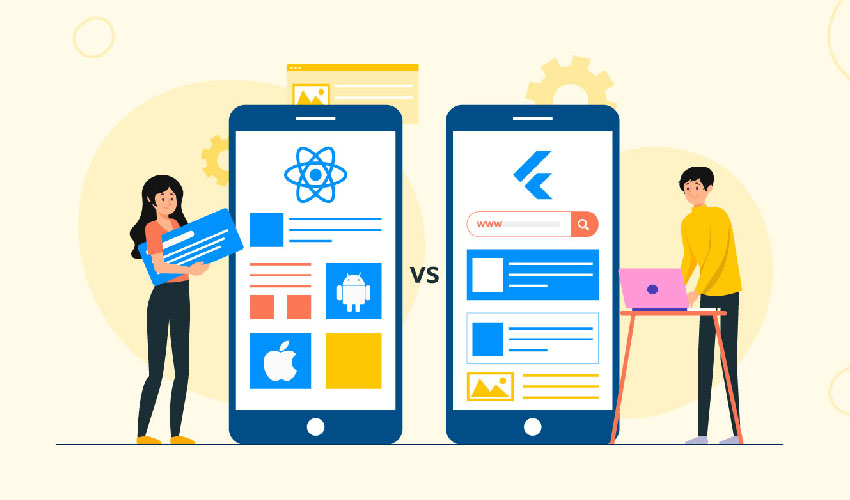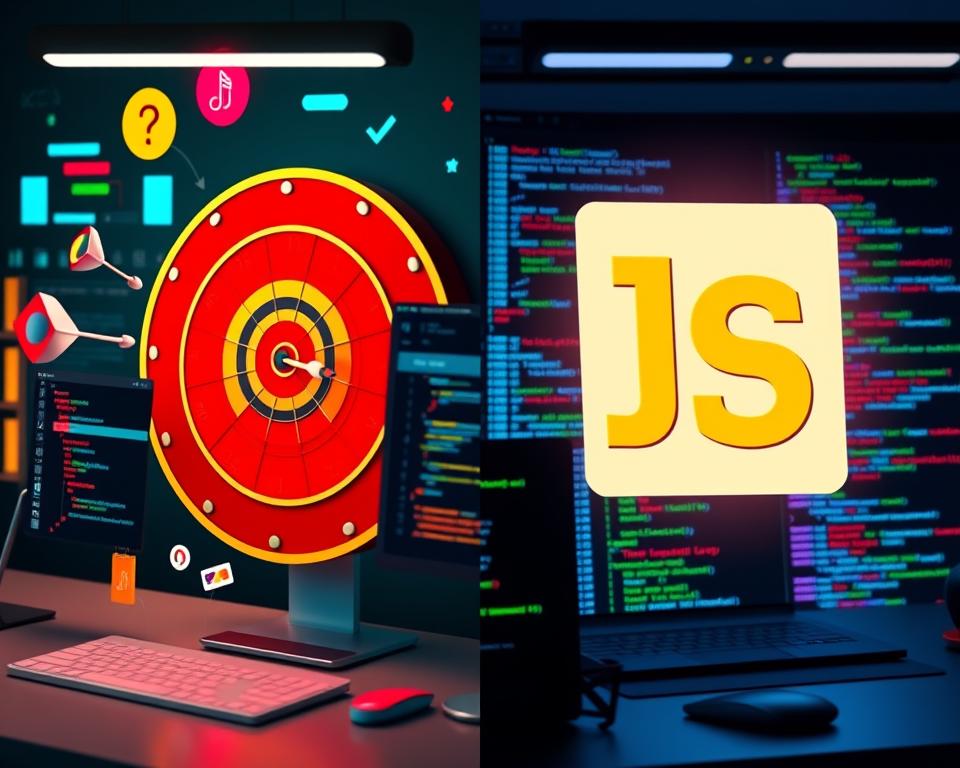In the world of mobile app development, picking the right framework is key. React Native and Flutter are top choices, each with its own strengths. They help developers make apps that work well on many devices, saving time and money.
This article compares React Native and Flutter in detail. We’ll look at their tech, how to use them, and what they offer. By the end, you’ll know which one is best for your app, whether you’re an expert or just starting out.
Table of Contents
Key Takeaways
- React Native and Flutter are two leading cross-platform development frameworks, each with its unique strengths and considerations.
- The choice between the two frameworks depends on factors such as technical architecture, development environment, programming language, UI components, and performance metrics.
- Both frameworks have strong community support and a growing ecosystem of third-party libraries and tools, but their adoption and usage vary across industries.
- Evaluating the cost, resources, and deployment requirements is crucial when selecting the framework that best fits your mobile app development needs.
- Understanding the performance, testing, and debugging capabilities of each framework is essential for building high-quality, cross-platform mobile applications.
Understanding Cross-Platform Development Frameworks
The world of mobile app development has changed a lot lately. Cross-platform frameworks have made it easier to create apps that work on many platforms. Frameworks like React Native and Flutter have changed how we make apps. They offer code reusability, native performance, and better development efficiency.
What Makes a Framework Cross-Platform?
A cross-platform framework lets you write code once for many operating systems, like iOS and Android. It uses a shared codebase. This way, developers can focus on the app’s main features without worrying about platform details.
The Evolution of Mobile Development Solutions
- Native development: In the early days, making apps for each platform took a lot of time and money.
- Hybrid development: Hybrid frameworks, like Cordova and Ionic, started cross-platform development. But, they had some native performance issues.
- Modern cross-platform solutions: React Native and Flutter have taken cross-platform development to a new level. They offer a seamless experience and native-like performance.
These modern frameworks are getting more popular. They provide high-quality, multi-platform development solutions. This meets the need for efficient and cost-effective app development.
A Brief History of React Native and Flutter
The mobile app world has changed a lot thanks to React Native and Flutter. These tools make building apps easier and cheaper than old ways. They help developers make apps that look and work like native ones.
React Native started in 2015 by Facebook. It lets developers use JavaScript and React to make apps. Big names like Instagram, Airbnb, and Pinterest use it.
Flutter came out in 2018 from Google. It’s different because it uses its own engine, Skia, for better performance. It’s based on Dart, another Google language, and is getting popular fast.
| Framework | Developed By | Initial Release | Programming Language |
|---|---|---|---|
| React Native | 2015 | JavaScript | |
| Flutter | 2018 | Dart |
Both React Native and Flutter keep getting better. They add new stuff, make apps run smoother, and make coding easier. They’re now top choices for making apps, helping many businesses and developers.
Technical Architecture Comparison
When we talk about making mobile apps for different platforms, the tech behind them is key. We’ll look at how React Native and Flutter differ. This will help us see how they affect app development and how the app works.
React Native’s Bridge Architecture
React Native uses a JavaScript bridge to talk to native parts of the app. This bridge lets JavaScript and native parts communicate back and forth. This makes React Native apps feel more like native apps.
Flutter’s Skia Engine Approach
Flutter uses its own Skia engine for rendering. It compiles Dart code into native code. This means Dart can talk directly to native parts and the Skia engine, without needing a bridge.
Performance Implications
The way React Native and Flutter work affects how fast and smooth apps are. React Native’s bridge might slow things down a bit. But Flutter’s Skia engine makes things run smoother and faster.
| Feature | React Native | Flutter |
|---|---|---|
| Architecture | JavaScript bridge | Skia engine |
| Native Components | Communicates with native components through the bridge | Directly integrates with native components |
| Rendering Engine | Leverages native rendering engines | Uses the Skia rendering engine |
| Performance | Bridge communication can introduce overhead | Efficient and seamless rendering |
Choosing between React Native and Flutter depends on your project’s needs. Think about what you want, what you’re willing to give up, and your team’s skills. Knowing how each works can help you pick the best one for your project.
Development Environment and Setup Requirements
Setting up a development environment is key for cross-platform projects. React Native and Flutter, two top frameworks, have different approaches. This affects how well developers can work.
React Native: Streamlined Setup
React Native makes setting up easy. It uses JavaScript, which many developers already know. You can pick your favorite IDE, like Visual Studio Code or WebStorm.
You’ll need to install Node.js, npm, and the React Native CLI. Then, set up emulators or connect devices for testing.
Flutter: Comprehensive Setup
Flutter’s setup is more detailed. It needs the Flutter SDK and Dart programming language. You’ll also need platform-specific development tools and emulators.
Developers often use Android Studio or Visual Studio Code. These IDEs offer a smooth experience with Flutter.
Even with a more complex setup, Flutter’s thorough approach helps. It makes sure developers can focus on creating great apps without too much hassle.
“The development environment and setup requirements for cross-platform frameworks like React Native and Flutter play a crucial role in the overall efficiency and productivity of the development workflow.”
Programming Languages: Dart vs JavaScript
Choosing a programming language is key in cross-platform development. It affects the development process, learning curve, and productivity. JavaScript and Dart are the main languages for React Native and Flutter, respectively. Let’s compare these languages and see what makes them special.
Learning Curve Comparison
JavaScript is a dynamic language that’s easy to learn. Developers familiar with JavaScript or similar languages can quickly start with React Native. Dart, a statically typed language, might be harder for newbies. But, Dart’s static typing helps in keeping code clean and catching errors early.
Developer Experience and Productivity
Both JavaScript and Dart offer great experiences for developers. JavaScript’s vast ecosystem makes development easier. Developers might find it more comfortable working with JavaScript.
Dart, on the other hand, focuses on making development efficient. Its integration with Flutter provides a smooth experience, especially for those already using Dart.
| Feature | JavaScript (React Native) | Dart (Flutter) |
|---|---|---|
| Language Type | Dynamic Language | Static Typing |
| Syntax Comparison | Familiar to many developers | Similar to Java/C#, may require learning curve |
| Ecosystem and Tools | Extensive, with a vast number of libraries and tools | Growing, but not as extensive as JavaScript |
| Developer Productivity | High, due to familiarity and existing tools | High, with Dart’s focus on developer experience |
The choice between JavaScript and Dart depends on the team’s skills and project needs. Both languages have their strengths and can lead to successful apps.
UI Components and Design Capabilities
The user interface (UI) and design are key in cross-platform development. React Native and Flutter both have strong UI components and design tools. They meet the needs of today’s mobile apps.
React Native uses Material Design guidelines. It has many pre-built UI components like buttons and text inputs. These can be customized to make apps look good on all platforms.
Flutter focuses on Cupertino widgets for a native iOS look. Its components, like scrollable lists and app bars, follow Cupertino design. This makes iOS users feel right at home.
Both frameworks let developers make custom widgets. This is great for creating unique UI elements. It’s important for apps that need to look good on different devices.
| Feature | React Native | Flutter |
|---|---|---|
| Pre-built UI Components | Material Design-inspired | Cupertino (iOS-inspired) |
| Customization Options | Highly customizable | Highly customizable |
| Custom Widget Creation | Supported | Supported |
| Responsive Layouts | Supported | Supported |
In summary, React Native and Flutter offer great UI components and design tools. They help developers make beautiful and responsive mobile apps for different platforms.
Performance Metrics and Benchmarks
Performance is key in cross-platform mobile development. React Native and Flutter are leaders, each with its own way to improve performance. Let’s look at the main performance metrics and benchmarks that make them different.
App Size Comparison
The size of an app is important for performance. Flutter apps, made with Dart and Skia, are generally smaller than React Native apps. This is good for users with little storage or slow internet, as apps download and install faster.
Runtime Performance
How well an app runs is vital for a good user experience. Flutter’s Dart and Skia engine make it fast and smooth. React Native’s JavaScript bridge might cause some lag, though.
Memory Usage
Using memory wisely is also crucial. Flutter is better at this, thanks to Dart’s memory handling. React Native needs more work to avoid memory issues.
Both React Native and Flutter are great for cross-platform apps. But, their performance can differ based on your project’s needs. It’s smart to test and compare them to find the best fit.
Community Support and Ecosystem
The strength of a framework’s community and ecosystem is key in cross-platform development. Both React Native and Flutter have strong communities. These communities offer valuable resources, support, and opportunities for developers.
The React Native community is large and active. It has many developers who help grow the framework. You can find answers on StackOverflow, learn from many resources, and work together on GitHub. This community’s hard work has helped React Native evolve quickly.
Flutter’s community is younger but growing fast. It has lots of learning resources, active forums, and a big GitHub ecosystem. The Flutter community’s enthusiasm has helped the framework grow quickly.
| Metric | React Native | Flutter |
|---|---|---|
| StackOverflow Questions | 169,000+ | 116,000+ |
| GitHub Stars | 104,000+ | 151,000+ |
| Meetup Groups | 400+ | 600+ |
| Conferences/Events | ReactConf, React Native EU | Flutter Interact, Flutter Europe |
The table shows the strong communities around React Native and Flutter. These communities offer lots of resources and support to developers.
“The community support and ecosystem are crucial factors in the success of any technology. Both React Native and Flutter have thriving communities that contribute to their continued growth and adoption.”
Choosing between React Native and Flutter depends on personal preference and project needs. But both frameworks have strong communities and ecosystems. This support can greatly help developers.
Third-Party Integration and Plugin Availability
Third-party integrations and plugins are key in cross-platform development. They can greatly impact the development process. Both React Native and Flutter have large ecosystems with many libraries and tools.
Popular Libraries and Tools
React Native has a huge collection of libraries and tools through npm. React Navigation is popular for routing, Redux for state management, and React Native Firebase for cloud services. Flutter’s pub.dev has a similar range of package managers and SDKs.
Both platforms have strong community support. This means developers can find many solutions for their needs. It helps speed up development and improve user experience.
Package Quality Assessment
Choosing third-party packages requires checking their quality and reliability. Look at downloads, active development, and user reviews. npm and pub.dev offer tools to help assess package quality.
Using the strong third-party integration in React Native and Flutter speeds up development. It allows for delivering rich and tailored user experiences.
Testing and Debugging Tools
In cross-platform mobile development, unit testing and integration testing are key. They ensure your app’s quality and reliability. React Native and Flutter provide tools to help developers improve their workflow and create top-notch apps.
Unit Testing and Integration Testing
React Native uses Jest for testing, making it easier to write and run unit tests. Tools like Enzyme and Detox help with integration testing. They let developers test how the app works on different platforms.
Flutter’s testing tools are based on Dart. Flutter Driver and mockito help with unit and integration testing. These tools help developers test their Flutter apps thoroughly.
Debugging Techniques
- React Native’s hot reload lets developers see code changes instantly. This speeds up the debugging process.
- Flutter’s hot reload also makes rapid code changes possible. It helps developers find and fix issues quickly.
- Both frameworks have strong debugging tools. The React Native Debugger and Flutter Inspector offer detailed insights into app performance and behavior.
Choosing between React Native and Flutter depends on your team’s skills, project needs, and personal taste. Both offer great tools for testing and debugging. They help you build reliable and high-quality mobile apps.
Deployment and CI/CD Integration
React Native and Flutter are frameworks for cross-platform app development. They have different ways to deploy apps. Knowing how to build and release apps on each platform is key for a smooth delivery.
Platform-Specific Build Processes
React Native has different build paths for iOS and Android. Developers must set up Xcode and Android Studio. They also need to manage specific dependencies and ensure apps work the same on all devices.
Flutter, on the other hand, uses one codebase for all platforms. This makes building and distributing apps simpler and more unified.
Release Management
Continuous integration (CI) and continuous delivery (CD) are vital for app releases. React Native works well with tools like app store submission, automated testing, and release automation. This helps teams automate the build, test, and deploy steps.
Flutter also has strong CI/CD integration. It supports platforms like continuous integration and release automation.
| Feature | React Native | Flutter |
|---|---|---|
| app store submission | Separate build pipelines for iOS and Android | Unified build process for both platforms |
| continuous integration | Well-integrated with popular CI/CD tools | Robust CI/CD integration options |
| automated testing | Comprehensive testing ecosystem | Extensive testing capabilities |
| release automation | Streamlined release management workflows | Efficient release automation processes |
Knowing how React Native and Flutter handle deployment and CI/CD helps developers. They can choose the best approach for their app delivery. This ensures apps are rolled out smoothly across platforms.
Cost and Resource Considerations
When choosing between React Native and Flutter for cross-platform development, cost and resources matter a lot. These factors affect your project’s time, team size, upkeep costs, and future support.
React Native uses JavaScript and might need a bigger team for its complex bridge architecture. This could mean longer development time and a larger team size. But, its wide range of libraries and tools could help balance these costs, especially for teams already familiar with JavaScript.
Flutter, built on Dart and Skia engine, might be faster to develop and could need a smaller team size. Its single codebase and strong performance could also lower maintenance costs and improve long-term support.
| Metric | React Native | Flutter |
|---|---|---|
| Development Time | Potentially longer due to bridge architecture complexity | Shorter development cycles due to Dart language and Skia engine |
| Team Size | Larger team required to handle platform-specific integration and bridge architecture | Smaller team possible due to unified codebase and Dart language |
| Maintenance Costs | Higher due to platform-specific integrations and potential bridge architecture issues | Lower maintenance costs thanks to the unified codebase and performance characteristics |
| Long-term Support | Potentially more challenging due to platform-specific dependencies and bridge architecture | Easier to maintain and support in the long run due to the Dart language and Skia engine |
When deciding on React Native or Flutter for your project, think about your needs, team skills, and future plans. The right choice depends on your project’s specifics and your goals.
Market Adoption and Industry Usage
The world of cross-platform development is changing fast. React Native and Flutter are becoming key players. They help build mobile apps in new and exciting ways.
Success Stories and Case Studies
React Native has won over many big names. Facebook and Instagram use it, as do startups and big companies. Airbnb, Wix, and Walmart have all seen success with it.
Flutter is also making waves. Google, Alibaba, and Tencent are among its users. Groupon, Reflectly, and Hamilton have created amazing apps with it.
Industry Trends
React Native and Flutter are getting more popular. They’re favorites among enterprise adoption and startup preferences. React Native leads in market share, especially with industry leaders. Flutter is catching up, especially with startups, thanks to its ease of use and performance.
The future of cross-platform development looks bright. React Native and Flutter will keep shaping it. The choice between them will depend on the project’s needs and the team’s skills.
Conclusion
We’ve looked at the main differences between React Native and Flutter, two top frameworks for cross-platform apps. We’ve covered their technical setups, programming languages, UI features, performance, and support ecosystems. Our goal was to help developers and companies choose the best framework for their projects.
Both React Native and Flutter have big benefits for making apps that work on many platforms. React Native uses JavaScript and React, which developers already know. Flutter, on the other hand, uses Dart and Skia for fast performance and a customizable UI. It’s important to think about the learning curve, how fast you can develop, community support, and integration with other tools when picking a framework.
The decision between React Native and Flutter depends on your project’s needs, goals, and your team’s strategy. As mobile app development keeps changing, both frameworks keep improving. They offer great options for companies wanting to make top-notch apps for many platforms.


















